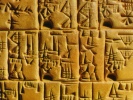
Sacred Texts Ancient Near East Records of the Past Egypt Index Previous Next


Records of the Past, 2nd series, Vol. II, ed. by A. H. Sayce, [1888], at sacred-texts.com
|
א |
a, ’ |
|
ל |
l |
|
ב |
b |
|
מ |
m |
|
ג |
g |
|
נ |
n |
|
ד |
d |
|
ס |
’s, s |
|
ה |
h |
|
ע |
e |
|
ו |
u, v |
|
פ |
p |
|
ז |
z |
|
צ |
ts |
|
ח |
kh |
|
ק |
q |
|
ת |
dh |
|
ר |
r |
|
י |
i, y |
|
ש |
s, sh |
|
כ |
k |
|
ט |
t |
N.B.—Those Assyriologists who transcribe ש by sh use s for ס. The Assyrian e represents a diphthong as well as ע.
________
In the Introductions and Notes W.A.I. denotes The Cuneiform Inscriptions of Western Asia, in five volumes, published by the Trustees of the British Museum.